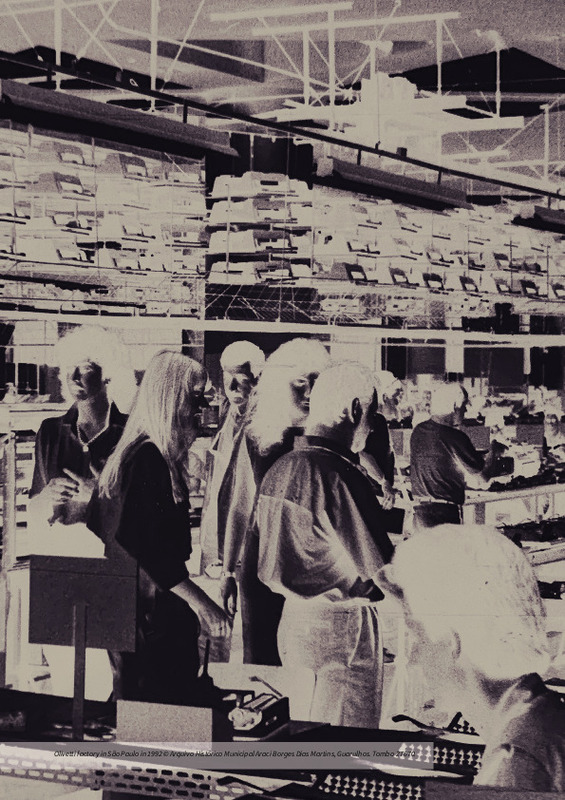|
Resumen:
|
[EN]
During the years of post-war reconstruction in Italy, the project represented an instrument of revenge on the ruins inherited from the war and industry seemed to be the answer to the needs of a society that was ...[+]
[EN]
During the years of post-war reconstruction in Italy, the project represented an instrument of revenge on the ruins inherited from the war and industry seemed to be the answer to the needs of a society that was rebuilding itself. The bond between project and industry thus spreads to all sectors of artistic production and the common thread is the use of words borrowed from the world of industry, thus raising the phenomenon of industrialisation.
Olivetti s experience is placed in this scenario, characterised by his interest beyond the factory, aimed at architectural, urban planning, cultural, publishing, and political issues. The Olivetti ideal focuses on aspects ranging from the typewriter to the city. The best architects work for Olivetti, and among them is Marco Zanuso. The factory is the topos of the project, in which theories of building industrialisation are synthesised. Zanuso experiments with the material s potential to address issues related to the factory; in the reinforced concrete, he discovers the possibility of rationalising the composition process. Thus, the structure finds the perfect balance between technique and expressive language, generating space, light, form, and function. The beam-pillar system, an ideal synthesis of the architecture for Olivetti in Argentina and Brazil, discloses the capacity to conceive space as a single entity, in which the recognisability of the construction system becomes the identifying key of the factory itself.
[-]
[IT] Durante gli anni della ricostruzione postbellica in Italia il progetto sembra costituire l unico strumento di rivalsa sulle rovine ereditate dalla guerra e, parallelamente, l industria sembra rappresentare la risposta ...[+]
[IT] Durante gli anni della ricostruzione postbellica in Italia il progetto sembra costituire l unico strumento di rivalsa sulle rovine ereditate dalla guerra e, parallelamente, l industria sembra rappresentare la risposta ai bisogni di una società che doveva ricostruirsi. Il connubio tra progetto e industria si estende così a tutti i settori della produzione artistica e pone come comune denominatore l utilizzo di vocaboli presi in prestito dal mondo dell industria, generando così il fenomeno dell'industrializzazione.In questo scenario si colloca l esperienza imprenditoriale di Olivetti, caratterizzata per il suo interesse posto al di là della fabbrica di macchine da scrivere, rivolto alle problematiche architettoniche e urbanistiche, culturali, editoriali e politiche. L'ideale di Olivetti può essere definito come focalizzato su aspetti che vanno dalla macchina da scrivere alla città. Per la Olivetti lavorano i migliori architetti italiani del periodo e tra questi si inserisce Marco Zanuso. La fabbrica è il topos della progettazione, in cui si sintetizzano le teorie dell industrializzazione edilizia. Zanuso sperimenta le potenzialità del materiale per affrontare le questioni relative all oggetto fabbrica, ritrova nel cemento armato le possibilità di razionalizzare le fasi del processo compositivo. Così la struttura ritrova il perfetto equilibrio tra tecnica e linguaggio espressivo, generatrice di spazi, di luce, di forme e di funzioni. Il dispositivo trave-pilastro, che trova perfetta sintesi nelle architetture realizzate per la Olivetti in Argentina e in Brasile, restituisce la capacità di concepire lo spazio della fabbrica come un unico oggetto, in cemento armato, in cui la riconoscibilità del sistema costruttivo diventa la chiave identificativa della fabbrica stessa.
[-]
[ES] Durante los años de reconstrucción de la posguerra en Italia, el proyecto parecía ser el único instrumento de revancha sobre las ruinas heredadas de la guerra y, al mismo tiempo, la industria parecía representar la ...[+]
[ES] Durante los años de reconstrucción de la posguerra en Italia, el proyecto parecía ser el único instrumento de revancha sobre las ruinas heredadas de la guerra y, al mismo tiempo, la industria parecía representar la respuesta a las necesidades de una sociedad que debía reconstruirse. La unión entre el diseño y la industria se extendió así a todos los sectores de la producción artística y el denominador común fue el uso de palabras tomadas del mundo de la industria, generando así el fenómeno de la industrialización.La experiencia empresarial de Olivetti se enmarca en este escenario, caracterizado por su interés en ir más allá de la fábrica de máquinas de escribir y abordar cuestiones arquitectónicas y urbanísticas, culturales, editoriales y políticas. El ideal de Olivetti puede definirse como centrado en aspectos que van desde la máquina de escribir hasta la ciudad. Los mejores arquitectos italianos de la época trabajaron para Olivetti, entre ellos Marco Zanuso. La fábrica es el topos del diseño, en el que se sintetizan las teorías de la industrialización de la construcción. Zanuso experimenta con el potencial del material para abordar cuestiones relacionadas con el objeto de fábrica, encuentra en el hormigón armado la posibilidad de racionalizar las fases del proceso de composición. Así, la estructura encuentra el equilibrio perfecto entre la técnica y el lenguaje expresivo, generando espacio, luz, forma y función. El dispositivo viga-pilar, que encuentra una síntesis perfecta en las arquitecturas realizadas para Olivetti en Argentina y Brasil, devuelve la capacidad de concebir el espacio de la fábrica como un objeto único, en hormigón armado, en el que la reconocibilidad del sistema constructivo se convierte en la clave identificadora de la propia fábrica.
[-]
|









